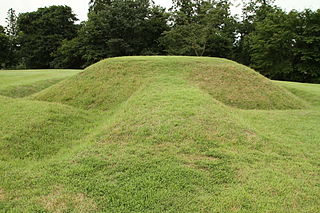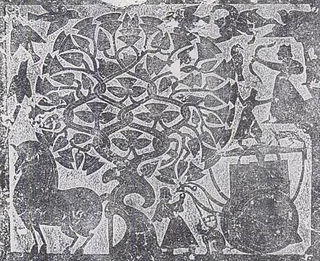 W
WThe Yayoi period , started at the beginning of the Neolithic in Japan, continued through the Bronze Age, and towards its end crossed into the Iron Age.
 W
WAtsuta Shrine is a Shinto shrine traditionally believed to have been established during the reign of Emperor Keikō (71-130) located in Atsuta-ku, Nagoya, Aichi Prefecture in Japan. The shrine is familiarly known as Atsuta-Sama or simply as Miya. Since ancient times, it has been especially revered, ranking with the Grand Shrine of Ise.
 W
WDōtaku (銅鐸) are Japanese bells smelted from relatively thin bronze and richly decorated.
 W
WFurutsu Hachimanyama Site is an archaeological park containing the remnants of a late Yayoi period moated settlement with three Kofun tombs located in Akiha-ku, Niigata in the Hokuriku region of Japan. The site was designated a National Historic Site of Japan in 2005.
 W
WFusang refers to several different entities in ancient Chinese literature, often either a mythological tree or a mysterious land to the East.
 W
WHida ruins is a group of archaeological sites containing the ruins of late Yayoi to early Kofun period settlements located in what is now part of the cities of Myōkō and Jōetsu, Niigata in the Hokuriku region of Japan. The site includes the Hida ruins (斐太遺跡)), Fukiage ruins (吹上遺跡) and the Kamabuta ruins (釜蓋遺跡)). The Hida ruins were designated a National Historic Site of Japan in 1977 and the Fukiage ruins and Kamabuta ruins followed in 2005.
 W
WThe Ise Grand Shrine , located in Ise, Mie Prefecture of Japan, is a Shinto shrine dedicated to the sun goddess Amaterasu. Officially known simply as Jingū (神宮), Ise Jingū is a shrine complex composed of many Shinto shrines centered on two main shrines, Naikū (内宮) and Gekū (外宮).
 W
WThe Jizōden ruins is an archaeological site containing the ruins of a large-scale Yayoi period settlement located in what is now part of the city of Akita in the Tōhoku region of Japan. It also contains artifacts from the Jōmon period and the Japanese Paleolithic periods. The site was designated a National Historic Site of Japan in 1996. The site is maintained as an archaeological park with some reconstructed buildings.
 W
WKaigarayama shell midden is an archaeological site containing the ruins of a large-scale Yayoi period settlement with an associated shell midden located in what is now part of the city of Kiyosu, Aichi in the Tōkai region of Japan. The shell midden was designated a National Historic Site of Japan in 1971.
 W
WKibi was a kingdom of fourth century Western Japan. The Kingdom of Kibi covered most of what is today Okayama Prefecture. Today, the Kibi Road crosses the plain between Okayama and Soja, what was once the heartland of Kibi-no-kuni.
 W
WMagatama are curved, comma-shaped beads that appeared in prehistoric Japan from the Final Jōmon period through the Kofun period, approximately ca. 1000 BCE to the sixth century CE. The beads, also described as "jewels", were made of primitive stone and earthen materials in the early period, but by the end of the Kofun period were made almost exclusively of jade. Magatama originally served as decorative jewelry, but by the end of the Kofun period functioned as ceremonial and religious objects. Archaeological evidence suggests that magatama were produced in specific areas of Japan and were widely dispersed throughout the Japanese archipelago via trade routes.
 W
WMangyō Site is an archaeological park containing the remnants of a late Yayoi period to late Kofun period settlement located in what is now part of the city of Nanao, Ishikawa in the Hokuriku region of Japan. The site was designated a National Historic Site of Japan in 2003.
 W
WThe Matsurokan (末盧館) is a museum located in Karatsu, Saga Prefecture, Japan, dedicated to the Nabatake Site (菜畑遺跡), a National Historic Site acclaimed as "Japan's first paddy".
 W
WMukibanda Yayoi Settlement Site is the largest Yayoi period remains in Japan. The Mukibanda site is located in the low foothills of Mount Daisen in the cities of Daisen and Yonago, Tottori Prefecture. The Mukibanda site was designated a Monument of Japan in 1999.
 W
WNakoku was a state which was located in and around modern-day Fukuoka City, on the Japanese island of Kyūshū, from the 1st to early 3rd centuries. Much of what is known about it comes from ancient records of both China and Japan.
 W
WŌzakai Cave Dwelling is an archaeological site consisting of a cave dwelling in what is now part of the city of Himi, Toyama Prefecture in the Hokuriku region of Japan. The site was designated a National Historic Site of Japan in 1986.
 W
WŌzuka-Senbōyama Sites (王塚・千坊山遺跡群) is a group of archaeological sites located in what is now part of the city of Toyama in the Hokuriku region of Japan. The sites consist of the ruins of a settlement which existed from the late Jōmon period through Kofun period, a necropolis, and a keyhole-shaped kofun burial mound. These sites have been protected by the central government as a National Historic Site since 1952.
 W
WThe Sannō-Gakoi Site is an archaeological site located in the city of Kurihara, Miyagi Prefecture, in the Tōhoku region of northern Japan, containing the ruins of a late Jōmon period to Yayoi period settlement. The site was designated a National Historic Site in 1991 by the Japanese government.
 W
WShimoyachi ruins is an archaeological site containing the remnants of a middle Yayoi period settlement located in what is now part of the city of Kashiwazaki, Niigata in the Hokuriku region of Japan. The site was designated a National Historic Site of Japan in 1979.
 W
WThe Shingū ruins archaeological site containing a ruins of a village complex which was inhabited from the late Jōmon period through the Kamakura period, located in what is now part of the city of Okazaki, Aichi in the Tōkai region of Japan and were collectively designated a National Historic Site of Japan in 1976.
 W
WA Shinjū-kyō is an ancient type of Japanese round bronze mirror decorated with images of gods and animals from Chinese mythology. The obverse side has a polished mirror and the reverse has relief representations of legendary Chinese shén, xiān, and legendary creatures.
 W
WThe Tareyanagi Site is an archaeological site in the village of Inakadate, Aomori Prefecture, in the Tōhoku region of northern Japan. It contains the remains of rice paddy field from the Yayoi period. The remains were designated a National Historic Site in 2000 by the Japanese government.
 W
WToro is an archaeological site in Suruga Ward in Shizuoka City, 130 kilometres (81 mi) south of Tokyo, Japan. The remains there date to the 1st century CE, in the late Yayoi period, and was an administrative unit of the area. Discovered in 1943, it was excavated in 1947–48 and designated a Special Historic Site of Japan in 1952. Toro is also the name of the area surrounding it in the Japanese addressing system.
 W
WUrigō ruins is an archaeological site containing the ruins of a Yayoi period settlement, located in what is now part of the city of Toyohashi, Aichi Prefecture in the Tōkai region of Japan. It was designated a National Historic Site of Japan in 1953.
 W
WYamamoto ruins is an archaeological site containing the ruins of a Yayoi period settlement located in what is now part of the city of Murakami, Niigata in the Hokuriku region of Japan. The site was designated a National Historic Site of Japan in 2016.
 W
WYayoi pottery is earthenware pottery produced during the Yayoi period, an Iron Age era in the history of Japan, by an Island which was formerly native to Japan traditionally dated 300 BC to AD 300. The pottery allowed for the identification of the Yayoi period and its primary features such as agriculture and social structure.
 W
WYoshizaki-Suba Site Site is an archaeological site and the ruins of a Yayoi period settlement in what is now the city of Hakui, Ishikawa in the Hokuriku region of Japan. The site was designated a National Historic Site of Japan in 1983.